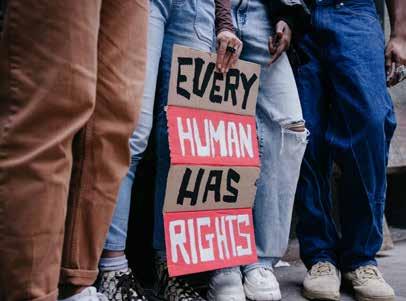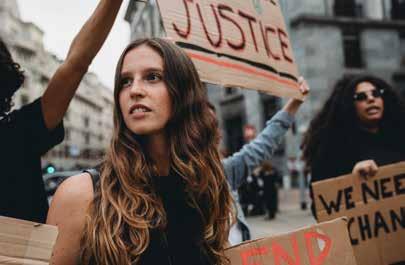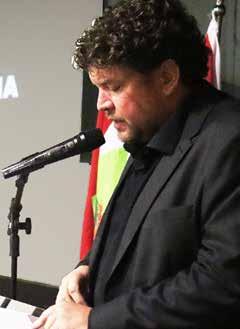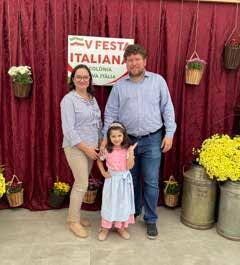The Voice of Maria Dolens
Year V April 2025

Monthly newsletter from the Peace Bell Foundation
Centenary of the Bell

Year V April 2025

Monthly newsletter from the Peace Bell Foundation
Centenary of the Bell
The “ReArm Europe” project, presented in early March by European Commission President Ursula von der Leyen and adopted by a large majority in the Strasbourg Parliament, has, as was easily predictable, sparked reactions that are far from unanimous in the public opinions of the 27 member states, as exemplified by lively street demonstrations, both in support of and against the project.
Eight hundred billion euros is indeed a substantial sum, and the concern of many, both in Italy and elsewhere, is that it may end up being “taken away” from priority civil sectors such as healthcare, education, and the environment—in
short, from the complex welfare system that Europe is rightly proud of, and which remains a valuable tool for reducing inequalities and promoting social inclusion. And in pursuing this line of reasoning, it is also often noted that the armed forces of the 27 states already receive significant funding, given that their total sum exceeds (and by no small margin) the budget allocated by the Russian Federation to its own military, which, as is well known, has been engaged for three years in an expensive (and criminal) war of aggression against neighbouring Ukraine.
To be continued on page 8...
02
What’s happening at the UN Peace and human rights
04 A Story of Trentini in the World Andrey José Taffner Frag from Mattarello to Santa Catarina, Brazil
06 For whom the Bell tolls Symbol and controversy
Direttore
The participation of the Campana dei Caduti Foundation in CSW69 is of particular importance and will be highlighted in the four-year report that the Foundation must submit to the UN by 1 June. This moment is particularly significant as 2025 marks a year of synthesis and revitalisation of policies for gender equality and the promotion of Peace. Moreover, the Foundation has been an active participant in the work of the United Nations Economic and Social Council (ECOSOC) since 2010 and has already passed three four-year reviews. This is also why, during the mission, as the Foundation’s envoy, I met with Pietro De Martin, the political coordinator and head of coordination of the activities of the IV Commission of the European Union at the UN. With De Martin there is a relationship of mutual trust built up over the years thanks to the mediation of the Director, Marco Marsilli, which led, among other things, to an interview with Radio Vaticano at the start of the celebrations for the Centenary of the first chime of Maria Dolens. In this case, the possibility that a UN representative give a speech in Rovereto as part of the Centenary was discussed with De Martin.
As always, the mission to New York was also an opportunity to forge relationships with local realities that have maintained a close relationship with the Bell for years, or that can initiate a dialogue with the Foundation. On Tuesday 12 March, for example, a meeting was held at the Italian Cultural Institute (IIC) with Silvia Mondargo and Alessandra Botta, cultural attachés, and Malina Mannarino, assistant director. The forthcoming appointment of the new Director and the possibility of starting a cooperation between the IIC and Maria Dolens based on sharing human rights work was discussed on this occasion.
There was another important opportunity for discussion with Eliseo De Marco, the president of the National Alpine Association (Ana) in New York, who expressed interest in collaborating with the Foundation in the near future. A further contact is planned during the Adunata degli Alpini, to be held in Biella in May.
Finally, on Sunday 16 March, I took part in a meeting at the headquarters of the Associazione Trentini nel Mondo, an opportunity to meet the Trentino community abroad, learn more about their activities, and talk about their Centenary initiatives. A ‘family’ meeting, which further strengthens the relationship between the Bell and the descendants of Trentino emigrants, each bringing with them a story that we constantly share on these pages in a dedicated column. And this has also led to the organisation, together with the

President of the Association, Michael Pancheri, of an online connection for 4 October, the date of the first chime of Maria Dolens.
The mission of the Campana dei Caduti Foundation at CSW69 was therefore part of an ongoing and lasting commitment to the promotion of Peace and human rights. Discussions with international institutions and participation in high-profile events have strengthened the Foundation’s role as a promoter of dialogue between peoples.
Peace is not just the absence of war, but the active construction of fairer societies. The words of the Beijing Declaration remain relevant and must be translated into concrete action. Our commitment continues. With the prospect of the UN’s quadrennial report and the centenary of the Bell, the Foundation looks to the future with determination, aware that the building of Peace passes through the recognition and protection of the rights of all.
Morena Berti


We asked some descendants of Trentino emigrants to tell their stories in their own words, emphasising how their origins have directed and influenced them in life. This would not have been possible without the active and friendly cooperation of the Trentini nel Mondo Association, founded in 1957 with the aim of social solidarity and as a tool of aggregation and assistance for Trentino migrants and their descendants. The character we introduce in this issue is Andrey José Taffner Frag, a university professor living in Brazil.
My name is Andrey José Taffner Fraga, and I am a descendant of Angelo Tafner, one of the pioneer immigrants in the founding of Rio dos Cedros (Santa Catarina - Brazil), who emigrated from Mat-

tarello (Trento) at the end of the 19th century. I am a university professor of commercial and tax law and I am also a tax lawyer. Although I am fully qualified, I have never managed to stop being a student. I have continued studying and today I am completing a PhD in law. I am married to Daniela Destefani. She too is a descendant of immigrants from Trentino (and Mantua), and we have a daughter named Angela. My name is not coincidental: I am descended from Angelo Tafner and Angela Perini, two of the first immigrants to Rio dos Cedros. Since my wife speaks the Trentino dialect fluently, step by step, we are teaching it to our daughter, who is now five years old, so that she too can inherit our rich cultural legacy.
In 2007, following in the footsteps of my grandfather, Olivio Taffner (one of the founders of the Trentino Circle of Rio dos Cedros, one
of the first Circles in Brazil), I too took an interest in the association movement. I joined the board of the Trentino Circle in my city with the intention of forming a group of young people. And indeed in the same year, 2007, the group (a dialect term meaning ‘young people’) was formed. The group has been active for several years, bringing the youth of the city closer to the associations of Trentino and carrying out a wide variety of activities.
The desire to have a deeper connection with my history, and my involvement in the associations of the Trentino area, also encouraged me to begin researching my family tree to trace the origins of my family, the Tafners. So I started investigating, interviewing relatives, collecting stories and facts and, above all, carrying out research in archives and registers to reconstruct my family’s genealogy.
At this point, I got in touch with Maria Antonietta Bellato Tafner, who had been studying the history of the Tafner family in the province of Trento for years By putting together the available research, including that done by Olivio Tafner, my grandfather, we were able, in 2017, to publish the book Famiglia Tafner: storia e traiettoria, in Europa e in Brasile, which recounts the history and genealogy of the family, from the first records in the Val dei Mocheni (14th century) to the present day. In the same year, we organised the great Tafner Family gathering in Santo Antônio, a district of Rio dos Cedros, the historical place where the immigrant Angelo Tafner arrived.
After researching my family history, I felt compelled to conduct a somewhat broader study on the presence and traces of Trentino culture in my city, Rio dos Cedros. This was a rather complicated search, as I had to identify the elements of Trentino culture that could still be verified in the city. I completed this inventory in 2019 and the result was a new book: Rio dos Cedros, il cuore trentino del Brasile, published in 2020 (bilingual Italian/ Portuguese). The official presentation to the community was postponed to 2021 due to the pandemic. Also in 2019, I participated as a delegate of the Autonomous Province of Trento in the “Seminar for the creation of a network of young Italians in the world” organised in Palermo by the General Council of Italians Abroad.
And it was precisely during those years of the pandemic that I was invited to undertake a new and unprecedented research project, in collaboration with Renzo Grosselli. The Trentino researcher and historian agreed to come to Rio dos Cedros and spend a few months in the city, interviewing residents and gathering material to write a work on cultural identity in a community of Trentino descendants, six generations after the first immigrations had occurred. After months of interviews and more than a year of work on the text, at the end of 2022, we witnessed the publication of the co-authored work, comprised of almost six hundred pages: Rio dos Cedros nella nostra mente, published by the Trentino Ethnographic Museum in San Michele.
In addition to these publications, several others of interest to the Italian community will be written, also in the legal field, one of them appearing in The Italian Yearbook of International Law
In 2022, I was appointed by the association Trentini nel mondo as Coordinator of the Trentino Circles of the States of Paranà and Santa Catarina, with an area of responsibility involving 29 Circles. It is one of the areas with the highest concentration of Trentino descendants worldwide. We immediately set to work, visiting cities and associations, to encourage the revival of activities in the post-pandemic


period. We were thrilled to undertake important initiatives, including the founding of two new Trentino Circles and reviving the activities of some associations that had stalled. In addition, we were able to strengthen the ties between the Trentino Circles and the Consulate General of Italy, which covers our region, thanks to the generous support fostered by Consul Eugenia Berti.
Finally, this year, 2025, marks 150 years of Italian immigration to Santa Catarina. I participated in the foundation of the state commission dedicated to the 150th anniversary, as well as the regional commissions and the municipal commission of Rio dos Cedros. There are many projects underway, in particular I am coordinating a book with a collection of studies featuring chapters written by different researchers on Italian immigration throughout Santa Catarina, which will be published this year.
Our work continues on multiple fronts. We divide our lives between family, academic work, the legal profession, a doctorate and the associations of Trentino, especially in this year of celebrations. We strongly believe that all this not only promotes a feeling of nostalgia, but can also create opportunities for the future. After all, the Trentino people, and also their descendants abroad, have always perfectly understood the concept (and advantages) of working in a network.
‘History is the witness of the times, the light of truth, the life of memory, the teacher of life’ wrote Cicero. If the classics are of any use, it is because they help us understand the present, and also history, even an event many centuries later, such as the one that saw the Campana dei Caduti at the centre of a controversy. After all, even today many monuments enter the public debate, testing the cohesion of a community, and sometimes its contradictions. Think, for example, about the statues of Columbus torn down in America, but that is another story.
The controversy surrounding Maria Dolens began with the statements of the new Director, Father Iori, who proposed the transfer of the Bell from the Castle to a “more suitable” location. The reason was
technical: the Malipiero bastion, dating back to the medieval period, could not support the weight and vibrations of the new Bell, which would have been larger than the previous one. In addition, the expected increase in the number of visitors called for reflection on the available space. The figures were clear: every year over 120,000 people went to admire what remained a symbol, but had also become a monument. The influx exceeded the reception capacity of the Castle, so there was no other choice.
Objections were raised immediately, mainly by the management of the War History Museum, located inside the building and the main beneficiary of the income from visits to the Bell, by virtue of an agreement signed in 1928 and reconfirmed several times. But it was not just a question of economics, there was

also respect for the wishes of the creator of Maria Dolens, who had imagined the Bell located next to the symbols of the city and Europe. Thucydides had shown remarkable foresight when he wrote that ‘history is a constant struggle between preservation and change’, and here again the choice between memory and practical necessity was at the heart of the problem.
In an attempt to find a solution, the mayor of Rovereto, Maurizio Monti, summoned representatives of the two institutions on 15 March 1961 in order to mediate and reach an agreement. After lengthy negotiations, it was agreed that the two bodies should not interfere with each other. The attempt was meritorious, but the tensions created did not subside. The president of the Museum, Livio Fiorio, even speculated about recourse to the judiciary, causing an internal crisis that led to his resignation in 1963. The mayor thus initiated a new mediation, which led to the signing of a document stating once again that the Bell was a symbol of Peace and collective memory.
Meanwhile, Father Iori continued with his project. On 20 March 1961, the Executive Committee of the Regency signed the contract with the foundry of engineer Paolo Capanni of Castelnovo ne’ Monti for the re-casting of the Bell.
Meanwhile, the National Congress of Lions Clubs, meeting in Alghero, pledged to fully finance the operation. ‘He who possesses money, possesses power’, wrote Machiavelli, although today one could say that it all depends on how you use it. In any case, the economic support provided made it possible to overcome the impasse.
But before the recasting could begin, the issue of the divestment of the ‘old’ Bell had to be addressed. The transfer took place at dawn on 20 May 1961 and was not without difficulties.

The removal work, which had begun the previous day, lasted so long that the crowd that had come to say goodbye to Maria Dolens dispersed before the event. The next day, a local newspaper printed a bitter headline saying that the Bell had left Rovereto as a ‘forgotten guest’. But it wasn’t over yet: the journey to the foundry was long and slowly turned into a sort of pilgrimage, with stops in various Italian cities. Enthusiasm, honours.
Sooner or later the journey had to end. It was time to look to the future. The Emilian foundry set to work. However, the question of the new arrangement of the Bell remained open, also because in previous years, the Trento Superintendency of Fine Arts had rejected proposals to change the area around the Castle. So the old arrangement could in no way have accommodated the new Bell.
Father Iori had already identified the place to which Maria Dolens would be transferred, located southeast of the city. On the map it said Valscodella, which as a name would not fit. With a swift stroke of the pen, the Director erased the label and confidently wrote “Miravalle.” No one objected. In fact, even today, just climbing up to the Foundation’s headquarters gives you a stunning view of the entire Rovereto plain and much of the Val Lagarina.
It was then a question of creating the structure to accommodate the Bell. A competition was announced on 4 January 1962. It was won by architect Mario Kiniger, who envisaged a stylised 67-metre high tower inside which the symbol of Peace would stand 15 metres above the ground.
This could not be done for technical reasons. The project was rejected by the municipal building commission. A new competition was launched in March 1964. The Rovereto-born architect Luciano Baldessari thought big and imagined the Bell suspended above an artificial lake to reflect the sound waves and channel them towards a semi-circular sail capable of sending them throughout the city. This could not be done either, it would have disturbed the architectural lines of the War Memorial located not far from the site of the new monument. It began to seem that the architects involved were assigning more importance to the structures that were to house the Bell than to the Bell itself. The frame, in short, appeared to have become more important and attractive than the painting. And after all, the controversy over the transfer had not yet subsided.

To be continued from page 1...
In fact, the main reason for the vulnerability of the European armies (in the plural) is primarily due to the inability to break free from the logic of national armed forces. This inevitably results in inefficiency, duplication (it is indeed disconcerting that there are as many as 12 different tank models in Europe!) and a lack of cost rationalisation.
Moreover, since the position of Commissioner for Defence is absent in the Brussels executive (a role occasionally mentioned by President von der Leyen without any practical follow-up), to whom could one entrust the challenging task of coordinating the foundations of a future European army, unifying command chains and operational procedures that have been consolidated over decades of nearly complete decision-making autonomy?
A discussion that had so far been “inter-European” was recently joined by a consideration of a different nature, prompted by the “historic” (in its most negative connotation, of course) meeting at the end of February at the White House between President Donald Trump and his Ukrainian counterpart, Volodymyr Zelensky. At the beginning of the conversation in the Oval Office Zelensky was an ally of the United States but ended it as an “unwelcome guest.”
leaving aside the erratic behaviour of the 47th President of the United States (evident also in other issues, such as tariffs), the episode mentioned above raises more than
a few doubts about whether Washington will continue indefinitely in its stance of “benevolent acquiescence,” which has translated since the post-war period into the assumption, by Uncle Sam, of much of the burden of our defence, particularly under the umbrella of NATO. This has been essential both in the past during the Cold War and today, in ensuring peace and security in the face of “hybrid threats” in a geographical area currently experiencing various shocks, on both the eastern and Mediterranean fronts.
Against this backdrop, Europe would be committing a serious blunder if it continued with business as usual and did not seriously equip itself to cope with potential external aggression, by increasing its own capabilities.
“ReArm Europe” (admittedly an unfortunate acronym) could therefore be used as both an encouragement (and at the same time a warning) to progressively transfer defence-related matters from the 27 national capitals and Brussels, allowing the European Union to move beyond its, albeit formidable, success story in the economic and social fields, and to lay the groundwork, for now, for the future creation of the United States of Europe.
An evolution, we are sure—despite opposing views—that the younger generations would be the first to benefit from.
Reggente Marco Marsilli, Foundation President